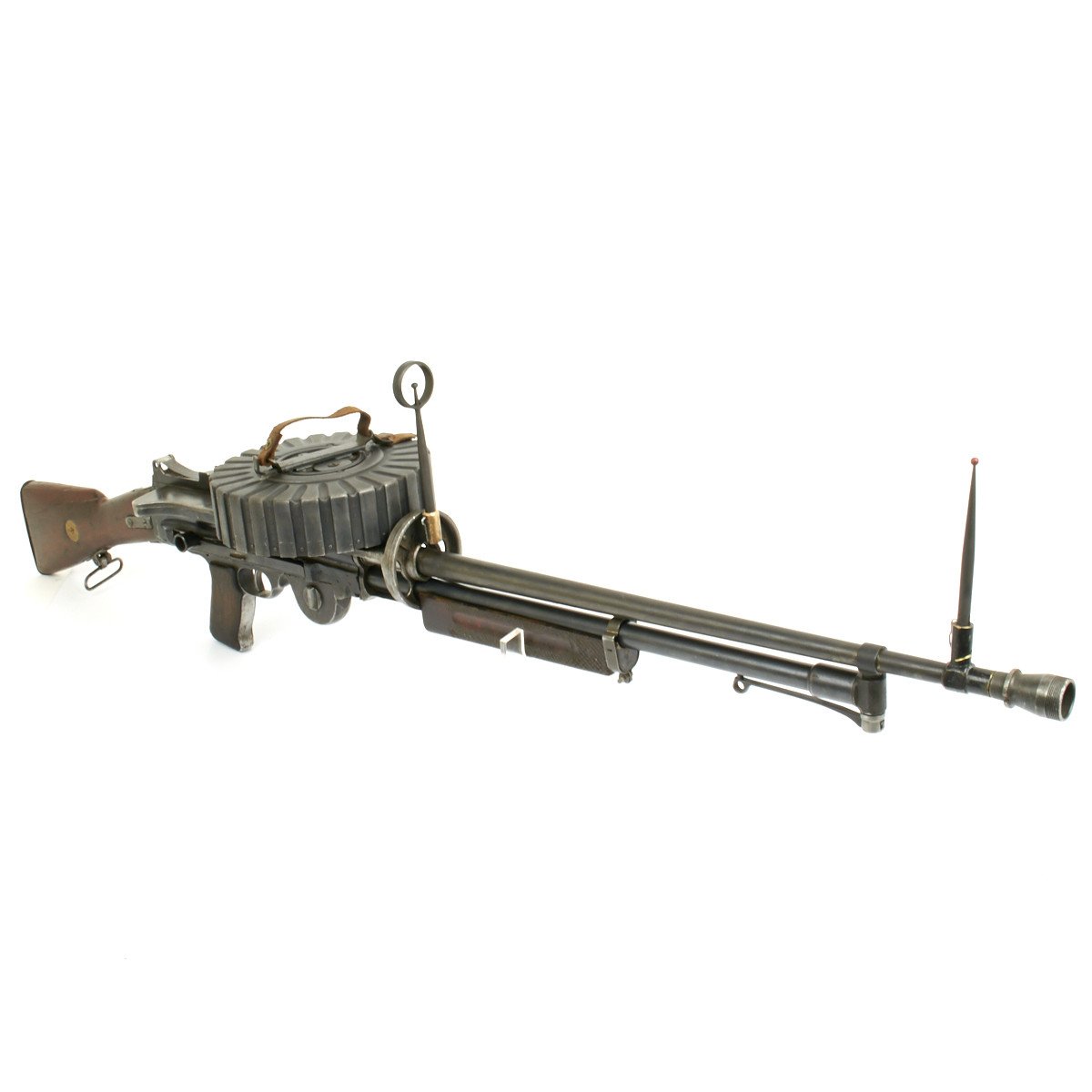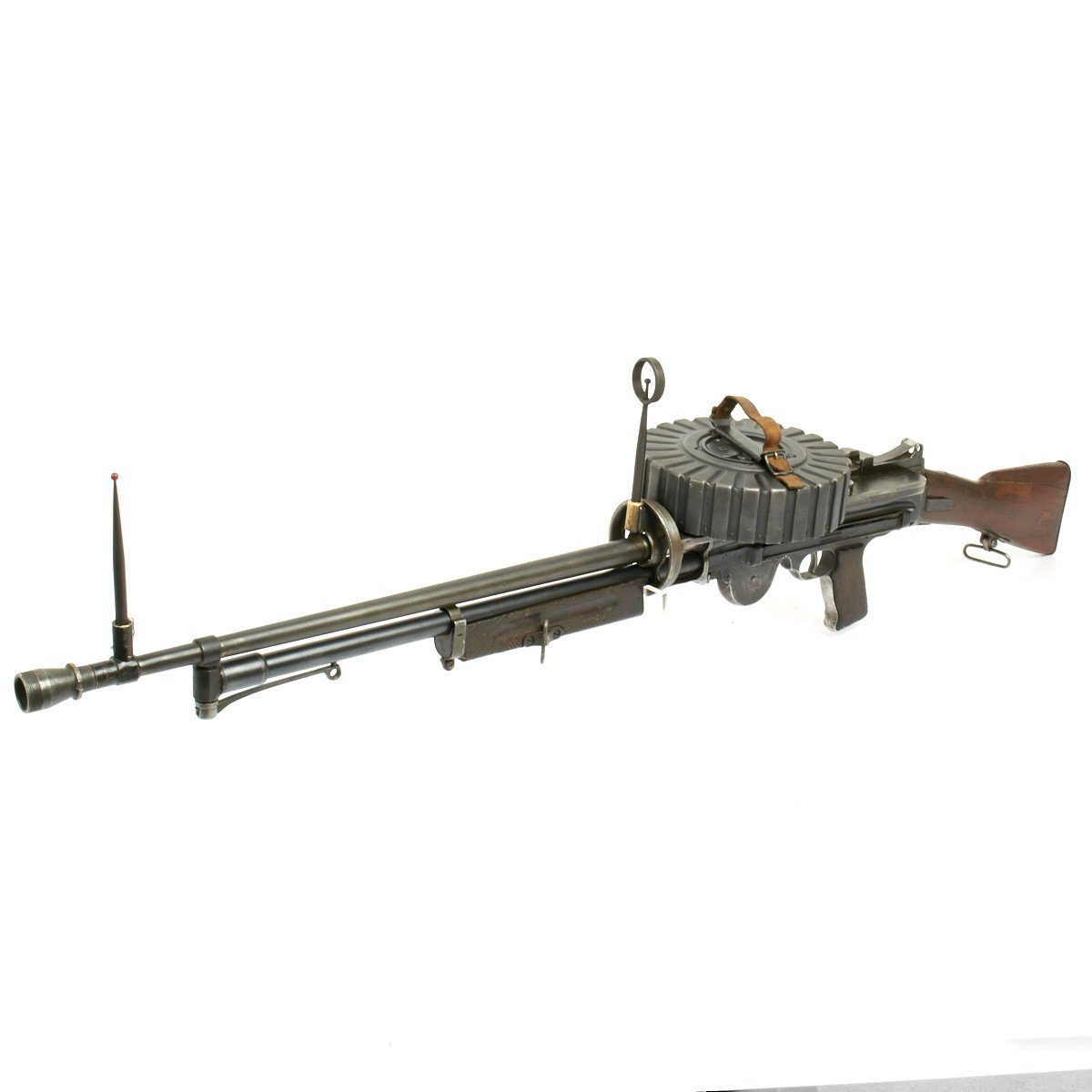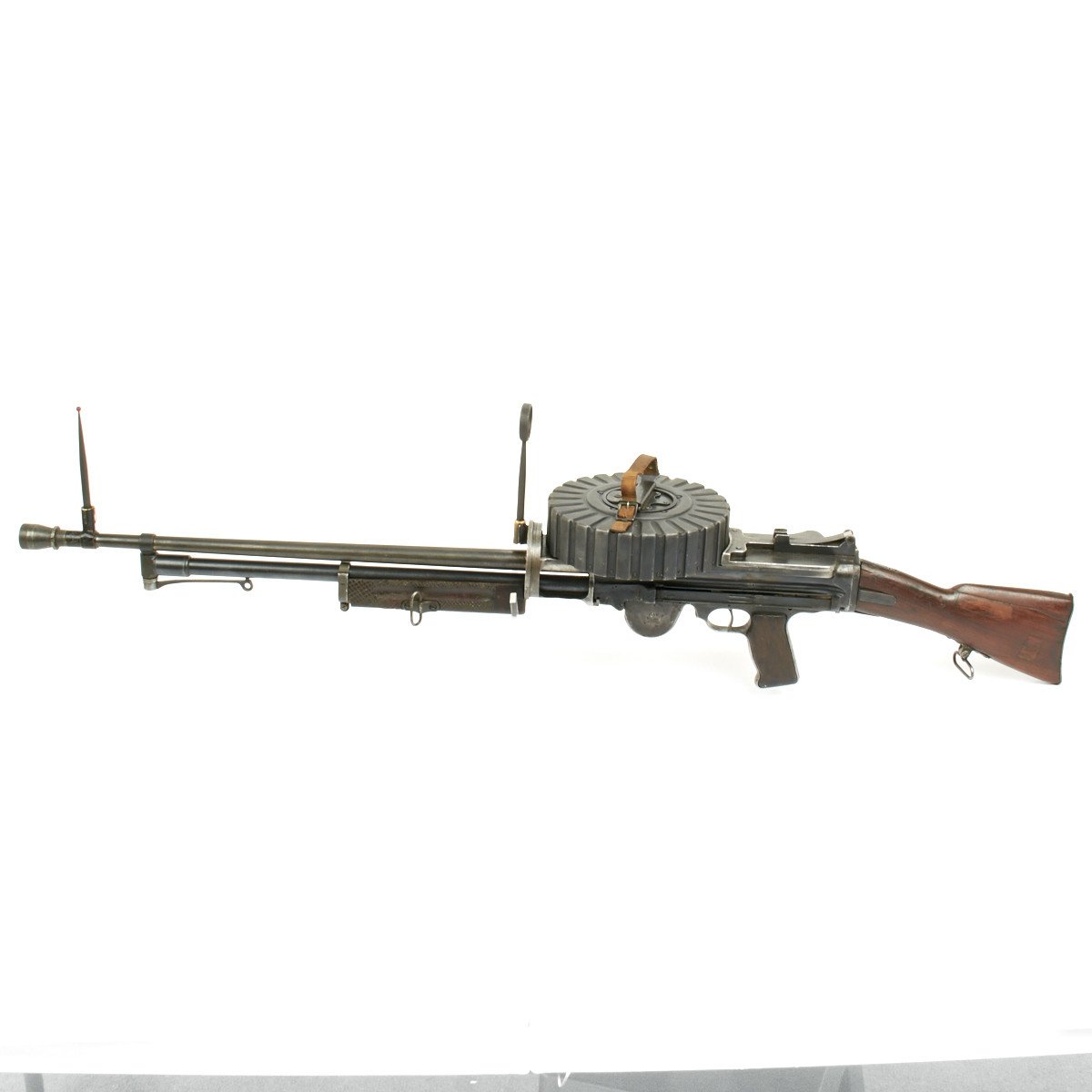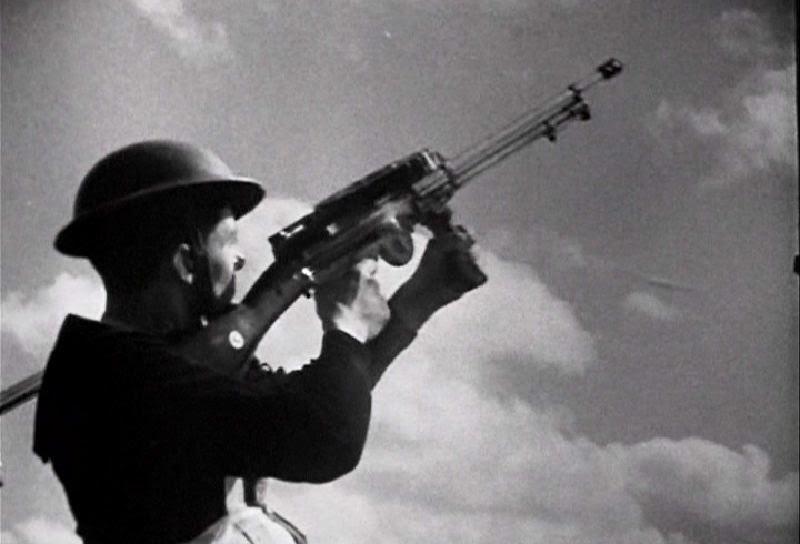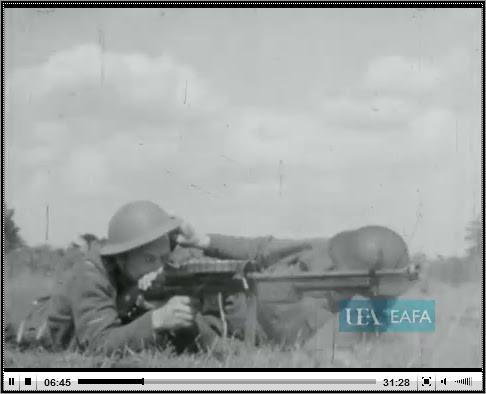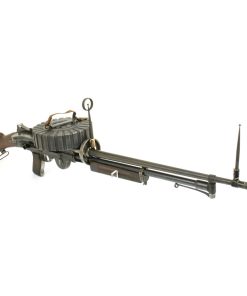Original British WWI Lewis Aircraft Gun Modified for WWII Home Guard with 97 Round Drum Magazine Original Items
$ 3.995,00 $ 998,75
Original Item: Only One Available. The Lewis gun has the distinction of being the first machine gun fired from an aeroplane; on 7 June 1912 Captain Charles Chandler of the US Army fired a prototype Lewis gun from the foot-bar of a Wright Model B Flyer.
By the time WW2 rolled around 20 years later aircraft technology had left these weapons in the dust, so it was decided to re-issue them to the British Home Guard (Dad’s Army) to meet the expected NSDAP invasion, which of course never materialized. These were now considered a portable weapon so no bipods or tripods were used other than for Anti-Aircraft purposes. The modifications were very simple, to put a wood Lewis Butt stock on the rear in lieu of the “D-Ring” grip and the addition of a wood fore grip under the barrel for the left hand.
This example is a BATF approved non-gun and utilizes much of the original steel Lewis receiver rebuilt as totally inert never to be made operational again and a parts set of original Lewis parts. It still retains its aircraft sights so no ladder back sight is needed or present and the wood fore end is a modified original British Thompson fore stock completely checkered in the British style with sling swivel on the left side which is held in place with a British WW2 Thompson Fore Stock ring bracket. This weapon has been completed with the very rare 97 round Aircraft Drum Magazine which is U.S. made and is in .30-06 caliber.
The Lewis gun was extensively used on British and French aircraft during World War I, as either an observer’s or gunner’s weapon or as an additional weapon to the more common Vickers. The Lewis’s popularity as an aircraft machine gun was partly due to its low weight, the fact that it was air-cooled and that it used self-contained 97-round drum magazines. Because of this, the Lewis was first mounted on the Vickers F.B.5 “Gunbus”, probably the world’s first purpose-built combat aircraft, when it entered service in August 1914, replacing the Vickers machine gun used on earlier experimental versions. It was also fitted on two early production examples of the Bristol Scout C aircraft by Lanoe Hawker in the summer of 1915, mounted on the port side and firing forwards and outwards at a 30° angle to avoid the propeller arc.
The need for forward-aimed aircraft mounts for the Lewis gun to avoid firing through the propeller arc on single-engined fighters resulted from the open bolt firing cycle of the Lewis, which prevented it from being synchronized to fire directly forward through the propeller arc of such aircraft; only the British F.B.5, Airco D.H.2 and Royal Aircraft Factory F.E.8 pusher fighters could readily use the Lewis as direct forward-firing armament early in World War I. British single-engined fighters could use the Foster mounting to elevate a Lewis gun above the propeller arc for unsynchronized firing, as was used on production S.E.5a fighters and on field-modified examples of the Avro 504. For the use of observers or rear gunners, the Lewis was mounted on a Scarff ring, which allowed the gun to be rotated and elevated whilst supporting the gun’s weight.[30] Lewis guns were often employed for balloon-busting, loaded with incendiary ammunition designed to ignite the hydrogen inside the gasbags of German Zeppelins, other airships and Drache barrage balloons.
Later, on the French Nieuport 11 and Nieuport 17 and the British S.E.5a and some versions of the Sopwith Camel and Bristol F2b fighter aircraft, the Lewis was fitted above the top wing on a Foster mount, which allowed firing directly forward outside the propeller arc. The Foster mount usually incorporated an arc-shaped I-beam rail as its rearmost structural member, that a Lewis gun could be slid backwards and downwards along the rail towards the cockpit, to allow the ammunition drum to be changed in flight but fighter ace Albert Ball V.C. also understood that the Lewis gun in such a mount also retained its original trigger, and could thus be fired upwards. He used the upward firing Lewis to attack solitary German two-seater aircraft from below and behind, where the observer could not see him or fire back. It was his use of the weapon in this way, in a Nieuport, that led to its later introduction on the S.E.5/S.E.5a. Ball had acted in a consultant capacity on the development of this aeroplane. The later Sopwith Dolphin, already armed with twin synchronized Vickers guns just forward of the pilot and just above its V-8 engine, also could use one or two Lewis guns mounted on the forward crossbar of its cabane structure, between the top wing panels as an anti-Zeppelin measure.
Lewis guns were also carried as defensive guns on British airships. The SS class blimps carried one gun. The larger NS class blimps carried two or three guns in the control car and some were fitted with an additional gun and a gunner’s position at the top of the gasbag.
The Lewis gun (or Lewis automatic machine gun or Lewis automatic rifle) is a World War I-era light machine gun of American design that was perfected and widely used by the British Empire. It was first used in combat in World War I, and continued in service with a number of armed forces through to the end of the Korean War. It is visually distinctive because of its wide tubular cooling shroud around the barrel and its top-mounted drum-pan magazine. It was commonly used as an aircraft machine gun, almost always with the cooling shroud removed, during both world wars.
Rebuilt from a vintage complete WW1 parts set using all original parts on a never to be reactivated (non-firing BATF approved) display receiver using most 80% of an original torch cut steel Lewis MG receiver, only the front had to be reconstructed. Internally it is totally inert and welded with no internal operational parts.
History of the Lewis Gun:
The Lewis gun was invented by US Army Colonel Isaac Newton Lewis in 1911, based on initial work by Samuel Maclean. Despite its origins, the Lewis gun was not initially adopted by the American militarymost likely because of political differences between Lewis and General William Crozier, the Chief of the Ordnance Department. Lewis became frustrated with trying to persuade the US Army to adopt his design and so (“slapped by rejections from ignorant hacks”, as he said), retired from the army. He left the United States in 1913 and headed to Belgium, where he established the Armes Automatique Lewis company in Liège to facilitate commercial production of the gun. Lewis had been working closely with British arms manufacturer The Birmingham Small Arms Company Limited (BSA) in an effort to overcome some of the production difficulties of the weapon. The Belgians bought a small number of Lewises in 1913, using the .303 British round, and in 1914, BSA purchased a licence to manufacture the Lewis machine gun in England, which resulted in Col. Lewis receiving significant royalty payments and becoming very wealthy. Lewis and his factory moved to England before 1914, away from possible seizure in the event of a German invasion. The Belgian Army acquired only a handful of his guns, probably only just in double figures. They were not on general issue in the Belgian Army. They were used only in a few forays by motor vehicles, south of Antwerp, against the flank of the invading German Army.
The onset of World War I increased demand for the Lewis gun, and BSA began production (under the designation Model 1914). The design was officially approved for service on 15 October 1915 under the designation “Gun, Lewis, .303-cal.” No Lewis guns were produced in Belgium during World War I; all manufacture was carried out by BSA in England and the Savage Arms Company in the US.
he first use of the Lewis in the War was by Belgium, in August and September 1914, when the small number available were fitted to a handful of touring and armoured cars and used in a few sorties against German patrols and troop columns. It is stated that as a consequence the Germans nicknamed the Lewis “The Belgian Rattlesnake,” but contemporary German references have not been found. The Lewis was not in service with the regular Belgian Army.
Great Britain officially adopted the Lewis gun in .303 calibre for land and aircraft use in October 1915, with the weapon beginning to be generally issued to the British Army’s infantry battalions on the Western Front in early 1916 as a replacement for the heavier and less mobile Vickers machine gun, the Vickers then being withdrawn from the infantry for use by specialist machine-gun companies. The US Navy and Marine Corps followed in early 1917, adopting the M1917 Lewis gun (produced by the Savage Arms Co.), in .30-06 caliber.
The US Army never officially adopted the weapon for infantry use and even went so far as to take Lewis guns away from US Marines arriving in France and replace them with the cheap, shoddy, and extremely unsatisfactory Chauchat LMG a practice believed to be related to General Crozier’s dislike of Lewis and his gun. The US Army eventually adopted the Browning Automatic Rifle in 1917 (although it was September 1918 before any of the new guns reached the front). The US Navy and Marine Corps continued to use the .30-06 caliber Lewis until the early part of World War II.
The Russian Empire purchased 10,000 Lewis guns in 1917 from the British government, and ordered another 10,000 weapons from Savage Arms in the US. The US government was unwilling to supply the Tsarist Russian government with the guns and there is some doubt as to whether they were actually delivered, although records indicate that 5,982 Savage weapons were delivered to Russia by 31 March 1917. The Lewis guns supplied by Britain were dispatched to Russia in May 1917, but it is not known for certain whether these were the Savage-made weapons being trans-shipped through the UK, or a separate batch of UK-produced units.
British Mark IV tanks used the Lewis, replacing the Vickers and Hotchkiss used in earlier tanks. The Lewis was chosen for its relatively compact magazines, but as soon as an improved magazine belt for the Hotchkiss was developed, the Lewis was replaced by them in later tank models.
The Germans also used captured Lewis guns in both World Wars, and included instruction in its operation and care as part of their machine-gun crew training.
Despite costing more than a Vickers gun to manufacture (the cost of a Lewis gun in 1915 was £165,[5] the Vickers cost about £100), Lewis machine guns were in high demand with the British military during World War I. The Lewis also had the advantage of being about 80% faster to build than the Vickers, and was a lot more portable; Accordingly, the British government placed orders for 3,052 guns between August 1914 and June 1915. By the end of World War I over 50,000 Lewis guns had been produced in the US and UK and they were nearly ubiquitous on the Western Front, outnumbering the Vickers by a ratio of about 3:1.
Deactivated magazine will be sent if not legal in destination location.
Fast Shipping with Professional Packaging
Thanks to our longstanding association with UPS FedEx DHL, and other major international carriers, we are able to provide a range of shipping options. Our warehouse staff is expertly trained and will wrap your products according to our exact and precise specifications. Prior to shipping, your goods will be thoroughly examined and securely secured. We ship to thousands clients each day across multiple countries. This shows how we're dedicated to be the largest retailer on the internet. Warehouses and distribution centres can be located throughout Europe as well as the USA.
Note: Orders with more than one item will be assigned a processing date depending on the item.
Before shipping before shipping, we'll conduct a thorough inspection of the items you have ordered. Today, the majority of orders will be delivered within 48 hours. The delivery time will be between 3-7 days.
Returns
The stock is dynamic and we cannot completely manage it because multiple stakeholders are involved, including our factory and warehouse. So the actual stock may alter at any time. It's possible that you may not receive your order once the order has been made.
Our policy is valid for a period of 30 days. If you don't receive the product within 30 days, we are not able to issue a refund or an exchange.
You can only return an item if it is unused and in the same state as the day you received it. You must have the item in its original packaging.
Related products
Uncategorized
Armoured Fighting Vehicles of the World: AFVs of World War One (Hardcover Book) New Made Items
Uncategorized
Uncategorized
Uncategorized
Uncategorized
Uncategorized
Uncategorized
Band of Brothers ORIGINAL GERMAN WWII Le. F.H. 18 10.5cm ARTILLERY PIECE Original Items
Uncategorized
Uncategorized
Uncategorized
Australian WWII Owen MK1 Machine Carbine SMG Custom Fabricated Replica with Sling Original Items
Uncategorized
Uncategorized
Angolan Rebel 1970s era 60mm Inert Display Mortar from Angolan Civil War Original Items
Uncategorized
Armored Burgonet Helmet & Polearm from Scottish Castle Leith Hall Circa 1700 Original Items
Uncategorized
Uncategorized
Uncategorized
Uncategorized
Uncategorized
Uncategorized
